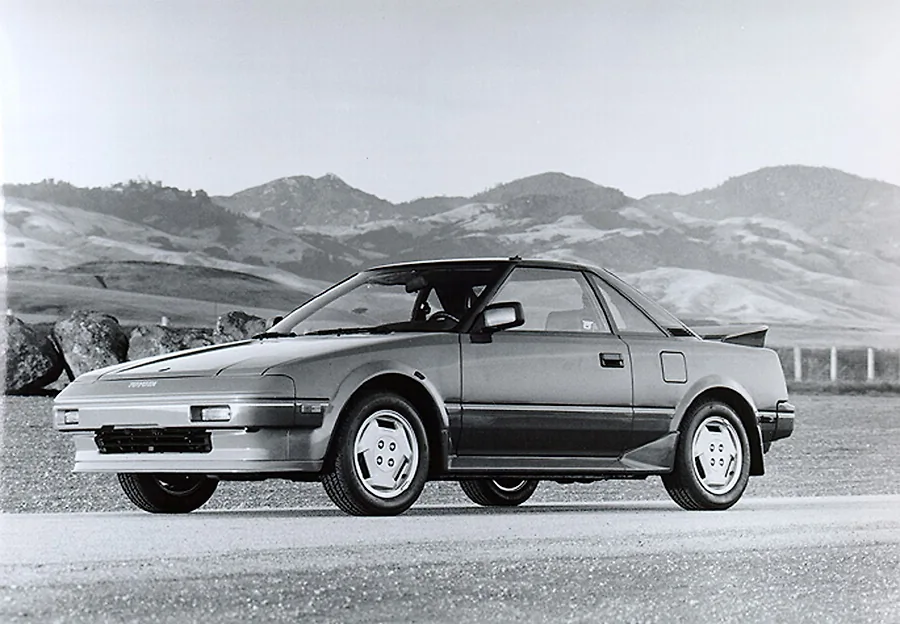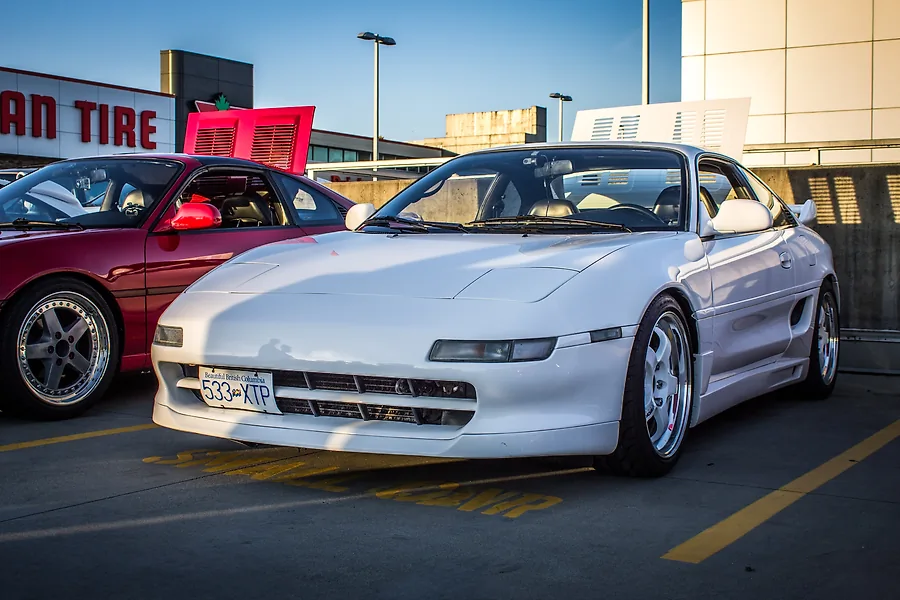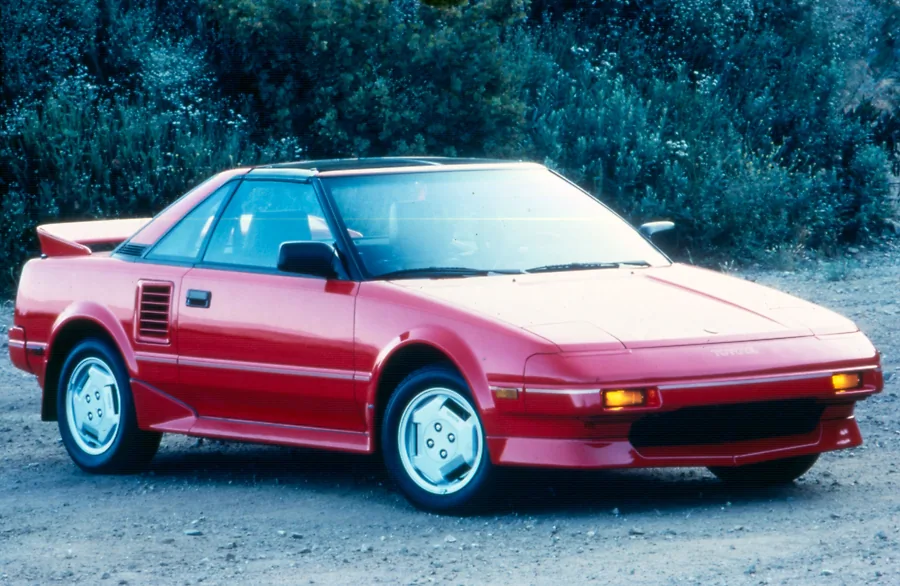Supercar engines are typically mounted in the middle. The reasons are fairly simple: if a large piece of metal is powering your car, it’s best to not to have it up front dragging the nose down or hanging out by the back bumper waiting to fling you into a ditch when you take a corner quickly. Even Porsche’s engineers, famously good at making quick cars with rear-mounted engines, sketched out a mid-engined configuration for their Le Mans winners and road-going supercars.
Lamborghini, McLaren, Bugatti, even ultraexotics from Pagani or Koenigsegg: the elite of automotive performance put the motor in the middle. But what about the rest of us? Does not the driving enthusiast of more modest means deserve the best dynamics possible? Happily, Toyota has long thought so. Even better, it looks as though the company’s about to make those mid-engine dreams come true once again.
Revealed earlier this year at the Tokyo Auto Salon, a special concept based on the Yaris is the strongest hint yet that there are plans afoot at Toyota to bring back the MR2 nameplate. If you remember the Yaris before it exited the Canadian market, it was a thrifty little hatchback, not so much a high performance machine. Not so the GR Yaris M Concept, which is based on the two-door widebody cousin to the GR Corolla sold here but that carries a two-litre four-cylinder engine mounted where the rear seats should be.
A production mid-engined hatchback is the kind of zany idea only a French manufacturer could pull off, as Renault did with the R5 Turbo, but think of the M Concept as a potential test bed for something sleeker. Two years ago, Toyota showed off a near production-ready two-seater concept called the FT-Se, although that was potentially supposed to be an EV. With more automakers not ready to snuff the candle on the combustion engine just yet, the ideas behind the two concepts could overlap to bring back the MR2.

Toyota already brought back the Supra nameplate. Company officials have confirmed that there’s a high-performance version of the Celica on the way. Resurrecting the MR2 would be part of an already established pattern.What a reborn MR2 could be like remains a mystery, for now. But perhaps we can learn some lessons by digging through Toyota’s past heritage of taking the layout of an exotic and packaging it with the accessible pricing of a Camry or Corolla.
The original first-generation MR2 hails from Japan’s bubble economy era, when no technological revolution seemed out of reach. Sony and Panasonic ruled consumer electronics, Sega and Nintendo revolutionized videogaming, and even usually conservative Toyota reckoned a risk or two might be in order.
The early concepts were called the SA-X and SV-3, but the production car had an entirely sensible name: M for mid-engined, R for rear wheel drive, 2 for two-seater. It wasn’t actually that much of a risk. Small mid-engined cars like the Fiat X1/9 already existed, so the concept was a proven one. By the time the MR2 went into production, Pontiac also had the mid-engine Fiero in showrooms, so perhaps the little Toyota sportscar was following the herd.
Nevertheless, it was something pretty special. The original concept was for a daily-driver car that was also fun on the weekends, something aimed at the hardworking salaryman who was riding solo to work anyway. The construction was lightweight, the engine used was a thrifty one shared with the Corolla, and the suspension was relatively simple.
By the end of the 1980s, Acura would shock the world with the NSX, a performance rival to the Ferrari 308. The first-generation MR2 was akin to a fun-size version of the Acura, but it laid out the recipe first. Honda (Acura’s parent company) had F1 champion Ayrton Senna sort out the NSX’s handling. Toyota had American F1 champ Dan Gurney shake down the MR2 at Willow Springs. Gurney stood over 1.9 metres tall, so it’s impressive that he actually managed to fit.

Then again, you don’t so much step into an early MR2 as you wear it. The car’s small cockpit puts everything within reach, and the visibility is excellent. The switchgear on the instrument binnacle can be operated by fingertip without removing your hands from the wheel, and the rest of the dash drops away for an even better view of the road ahead.
Toyota would eventually make a supercharged MR2, but the extra power necessitated extra weight from forced induction components and a stronger transmission. The sweet spot is the ordinary 1.6-litre four-cylinder-powered car, which on this side of the Pacific had just over 110 horsepower on tap. Little more was needed, as the MR2 handles like a sparrow, flitting across the tarmac from corner to corner. It’s perhaps a bit short on space for longer journeys, but a sortie down a wriggling backroad is a delight.
For the next generation of MR2, Toyota again followed automotive trends by introducing turbocharging. In the 1990s, everything from minivans to personal computers got turbo labelling (in the case of the home PC, it was just a button), as the word became almost completely interchangeable with “fast.”
The MR2 Turbo that launched in North America in 1990 as a 1991 model was certainly fast. It boasted nearly double the power of the original with a two-litre four-cylinder engine turbocharged to 200 horsepower and an even 200 lb-ft of torque. With slick new styling incorporating air ducts just aft of the doors, people started calling it a baby Ferrari.
With the ability to increase power by turning up the boost with relative ease (who needs factory warranty? It’s a Toyota), the MR2 developed a reputation as a seriously quick sports car that displayed tricky handling at the limit.
The issue was largely driver unfamiliarity with the handling characteristics of a mid-engined car. If you’d replaced your Civic Si or a rear-wheel-drive Corolla GT-S with an MR2 Turbo, you might find the car’s transition from mild understeer to oversteer difficult to catch. The key was smooth inputs, and owners who put in a bit of time into driver training soon learned how best to find the rewards of mid-engined dynamics.
Toyota also tweaked the cars to be a little easier to tame for the 1993 model year, but Canadian enthusiasts would soon be heartbroken. That was the last model year for the MR2 Turbo in Canada, though sales in the U.S. continued until 1995, and in Japan until 1999.


Further, when Toyota introduced the MR-S or MR2 Spyder, depending on market, Canada wasn’t one of the countries that got this MR2 replacement. It cleaved closer to the original’s lighthearted fun than the trickier second-generation Turbo, using a 1.8-litre engine with just under 140 horsepower on tap. With a proper soft-top, it was a sort of Toyota-badged rival to the Mazda MX-5.
When the first MR2 arrived on the scene, it wasn’t unusual for an ordinary enthusiast buyer to park a sports car in the driveway. Today, the market for affordable sports cars is tiny, with the flame preserved only by the Mazda MX-5, and Toyota GR86 and Subaru BRZ twins.

A modestly powered MR2 is thus unlikely in the future. Instead, perhaps, Toyota will be looking for a well-known nameplate to fill the void left by the departing Supra. That car is saying goodbye after the 2026 model year, and even if it’s not a volume-seller for Toyota, something else will need to step forward to provide a halo effect for the company.
Currently, the GR Corolla is handling the role of feisty hot hatchback hero, with 300 horsepower from a turbocharged three-cylinder engine. Toyota’s experimental four-cylinder two-litre could have more power baked in, perhaps enough to exceed the Supra’s 382-horsepower rating, tucked away behind the two seats of a small, svelte sports car.
While the potential for that car sits tantalizingly on the horizon, current MR2 owners already enjoy the fruits of the company’s long interest in mid-engined machines. Blasting through the drifts of autumn leaves, snapping through the curves, turning up the corners of its driver’s mouth—when you’re this much fun, they call you Mister Two.
Read more transportation stories.









